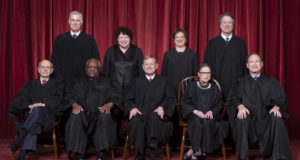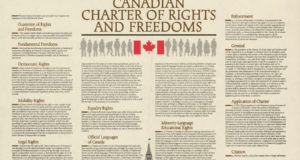This is the second of a two-part essay written by Professor Maxime St-Hilaire and Xavier Foccroulle Ménard. Part I can be read here.
Assessment of the Fourth Argument on British, Australian and New Zealand Law
While not convincing, we find the comparative argument to have more weight, and this despite the following clarification. Grégoire Webber, Eric Mendelshon and Robert Leckey give two examples taken from Australian law: that of the Human Rights Act 2004 of the Australian Capital Territory and that of the Charter of Human Rights and Responsibilities 2006 of the federated unit of Victoria. Section 32 of the former authorizes courts only to make “declarations of incompatibility,” while section 36 of the latter provides for “declarations of inconsistency” in a functionally equivalent manner. Nevertheless, as Léonid Sirota pointed out in his otherwise concurring opinion piece, in the Momcilovic[1] case involving the charter of the state of Victoria, the High Court of Australia held that the making of mere declarations of inconsistency was not the exercise of a judicial function, and that the law could not therefore constitutionally authorize the courts to make them. This leaves us with the British and New Zealand examples.
Section 4 of the British Human Rights Act 1998 in fact only allows the courts to make a “declaration of incompatibility,” which “does not affect the validity, continuing operation or enforcement of the provision in respect of which it is given.” As for the New Zealand Bill of Rights Act 1990, it merely provides at section 4 that the courts may not, under its terms, declare any legislative act (“enactment”) “impliedly repealed or revoked, or to be in any way invalid or ineffective,” or decline to apply any provision thereof. So, the Bill of Rights did not expressly contemplate that courts may make a declaration of inconsistency. It was by a slim three-to-two majority that in 2018, in the Taylor case, the Supreme Court of New Zealand upheld such a power.[2] Does the fact that British and New Zealand courts – by express statutory authority, constructed statutory authority or somehow their own authority – may make declarations of mere inconsistency of particular statutory provisions with human rights legislation support the view that Canadian courts may make such declarations, where the declared “inconsistency” is that of statutory provisions with constitutional provisions from which they validly derogate, under a power expressly provided for in the supreme law itself? No. These foreign examples have nothing to do with section 33 of the Canadian Charter of Rights and Freedoms.
Neither New Zealand nor the United Kingdom has a supreme written law, in the sense of formally constitutional, supra-legislative provisions. Their constitutional law, despite the wishes of some authors,[3] remains governed by the principle of parliamentary sovereignty, as opposed to constitutionalism, in the formal, supra-legislative sense of the term. In the case of Australia, the latter principle applies because it is a federation, yet the protection of fundamental rights is essentially excluded from it.[4] This already explains why no human rights law adopted by the legislature or, in the case of the Australian federation, by one of its legislative authorities, can condition the validity of other legislative provisions.[5] However, the attachment of these legislators to parliamentary sovereignty, at least in matters of fundamental rights, has convinced them to go so far as to rule out the possibility that their legislation on the latter subject might, in the event of a conflict of laws, render other legislative provisions inoperative. This is precisely how the possibility for courts in these countries to declare the mere inconsistency of given legislative provisions with their human rights legislation was either provided for by their human rights legislation or recognized by these courts themselves: as a means of ensuring that rights recognized in the legislation do not remain absolutely without a remedy against … the legislation. This is clear from the reasoning of the New Zealand Supreme Court decision in Taylor.[6]
The legal framework of this judicial practice cannot be compared with that of a Canadian court which would be asked to make a declaration on the relationship of statutory provisions to provisions of the supreme law from which they validly derogate, with express authorization. As Léonid Sirota himself insists, the legal framework and arguments for the protection of rights in countries that do not have what Jeremy Waldron calls “strong judicial review of legislation” [7] are not immediately transposable to the interpretation of Canadian constitutional human rights law, beginning with section 33 of the Canadian Charter of Rights and Freedoms.[8] Section 33 of the Canadian Charter does not pertain to the law of remedies. Its use is only subject to formal judicial review, but the result thereof is a temporary change in substantive law: the bracketing of Canadian Charter provisions that guarantee rights. Section 33 of the Canadian Charter is an attributive provision that gives Parliament and legislatures the power to temporarily exempt their provisions from judicial review based on certain substantive provisions of the Charter. In other words, with respect to legislative provisions that validly make exception of it by derogating form the Canadian Charter provisions which guarantee it, a constitutional right is temporarily non-existent—as the Ford decision indicated in distinguishing between derogation and limitation[9]—so that, on this particular issue of the relationship between that right and the provisions that are excepted from it, the courts have nothing to declare. Again, can one imagine for a moment New Zealand courts taking the liberty of declaring particular statutory provisions to be inconsistent with provisions of the New Zealand Bill of Rights Act 1990 when the former enactment would expressly provide that those provisions derogate from those rights? We do not think so.
The origins of judicial declarations are found, not in the common law, but in the continental “civilist” tradition.[10] This transplant required some adaptation. While the Anglo-American legal tradition holds that there is no right without a remedy (ubi jus ibi remedium),[11] it is also because it holds that there is no remedy without a corresponding right (or legal “interest”). This seems to be increasingly overlooked. Judges were initially reluctant to make declarations which did not seem to them to constitute genuine remedies.[12] The usefulness of such a remedy has come to be explained in large part by the principle that there can be no enforcement of judgments against the Crown.[13] The American scholar Edwin Borchard, who remains the most ardent and historically important advocate of the introduction of judicial declarations in common law countries, justified their importation by their ability to serve “a useful purpose in clarifying and settling the legal relations at issue.”[14] Today, some academics are calling on Canadian courts to issue declarations that are not only further deprived of effect, but devoid of a substantive object in the (be it temporary) absence of a legally existing (valid and in force) right. Of course, in Canada, the ability to make declarations on the law in force is part of the constitutionally protected power of those higher courts of review which are the superior courts. My argument does not directly fall within the realm of the law of procedure and remedies, just as section 33 of the Canadian Charter does not either.[15] Rather, it goes to the more fundamental idea that—save the (unfortunate) self-indulgence of appellate courts giving their opinion on constitutional conventions in a reference procedure where they are asked by the government[16]—our courts have no jurisdiction to decide matters other than of law that is existing, positive, and in force, and therefore have no jurisdiction to decide matters, be they substantial or procedural, that are legally hypothetical or otherwise virtual.
In Canadian law, it is only when a right has not been excepted from that it may constitute the basis for an application for a judicial declaration, which will be of invalidity – in the case of a Canadian Charter right which has not been derogated from under section 33 – or inoperability – in the case of a right protected by one of the (federal or provincial) “quasi-constitutional” human rights statutes but which is expressly set aside in the valid exercise of federally allocated legislative powers.[17] With less rigour, Canadian courts are also open to declaring that rights have been violated[18] or that the state has failed to meet its obligations.[19] When, on the contrary, a right has been validly excepted from, there is nothing to declare by the courts about the relationship between the valid exception provisions and the constitutional or quasi-constitutional provisions from which they are excepted. There can therefore be neither a violation of rights nor a breach of obligation to be decided upon, not even in the form of a simple declaration.
In 2018, the Supreme Court of Canada summarized the conditions under which a judicial declaration can be made in its Ewert decision:
A declaration is a narrow remedy but one that is available without a cause of action and whether or not any consequential relief is available: Manitoba Metis Federation Inc. v. Canada (Attorney General), 2013 SCC 14, [2013] 1 S.C.R. 623, at para. 143; P. W. Hogg, P. J. Monahan and W. K. Wright, Liability of the Crown (4th ed. 2011), at p. 37; L. Sarna, The Law of Declaratory Judgments (4th ed. 2016), at p. 88; see also Federal Courts Rules, SOR/98-106, r. 64. A court may, in its discretion, grant a declaration where it has jurisdiction to hear the issue, where the dispute before the court is real and not theoretical, where the party raising the issue has a genuine interest in its resolution, and where the respondent has an interest in opposing the declaration sought: see Daniels v. Canada (Indian Affairs and Northern Development), 2016 SCC 12, [2016] 1 S.C.R. 99, at para. 11; Canada (Prime Minister) v. Khadr, 2010 SCC 3, [2010] 1 S.C.R. 44, at para. 46; Solosky v. The Queen, 1979 CanLII 9 (SCC), [1980] 1 S.C.R. 821, at pp. 830-33.[20]
Our argument is quite simply that the courts have no jurisdiction to rule on the relationship between two legal norms, one of which, in this case a constitutional right, has been validly excepted from with respect to the other by virtue of an authorization expressly provided for in the supreme law. Such question is, indeed, theoretical.
At this stage of the argument, we expect to be objected the practice by which our courts would sometimes render declarations with regard to “future infringement of rights.” Our response is two-fold. First, in all honesty, the argument we are discussing was not framed this way. Second, had it been, then would it be reasonable to think that the courts do have jurisdiction to rule on the consistency of particular legislative provisions with the Canadian Charter provisions from which they are validly excepted, in anticipation that, about five years from now, such exception may not be renewed under section 33(4)? We do not think so. Perhaps the imminent expiration of such an exception would make a difference, but we doubt it very much. Furthermore, the question gives us an opportunity to elaborate a little more on the applicable case law. Above all, one should not misunderstand it by failing to distinguish between facts and legal norms. More specifically in our case, it is crucial to differentiate, on the one hand, the factual conditions for the violation of a right that have not yet been fulfilled while the right does exist legally and, on the other hand, a right that does not yet have legal existence, be it “again,” for it has been suspended with regard to the legal norm against which one would like to oppose it. This is precisely how the fact that the Supreme Court has actually never said that a declaratory judgment could be given on a future or past violation of rights is to be understood. The relevant excerpt from the 1980 Solosky decision is as follows:
The first factor is directed to the “reality of the dispute”. It is clear that a declaration will not normally be granted when the dispute is over and has become academic, or where the dispute has yet to arise and may not arise. As Hudson stresses, however, one must distinguish, on the one hand, between a declaration that concerns “future” rights and “hypothetical” rights, and, on the other hand, a declaration that may be “immediately available” when it determines the rights of the parties at the time of the decision together with the necessary implications and consequences of these rights, known as future rights. (p. 710)[21].
This statement was in no way contradicted by the Operation Dismantle decision in 1985, in which an uncontradicted majority confirmed that “[i]t is clearly illustrated by the rules governing declaratory and injunctive relief that the courts will not take remedial action where the occurrence of future harm is not probable.”[22] In other words, it was the future possible facts that were at issue, not the future existence of rights.
Assessment of the Fifth Argument on Section 24 not Being Listed in Section 33 of the Charter
Now remains the argument of section 24 of the Canadian Charter, which should not keep us busy for much longer. As I have explained about its relationship to section 28,[23] section 33 allows rights to be excepted from through the exception to some of the substantive provisions of the Charter that are rights-bearing. That is why it does not allow for exception from interpretive provisions such as section 28. This of course applies to section 24, the remedies section, which by definition does not contain substantive, rights-bearing provisions. There is therefore nothing surprising, nor is there a mine of hidden arguments, in the fact that no reference to section 24 is included in the provisions of section 33, among those to sections from which the latter allows Parliament and legislatures to derogate. For the foregoing reasons, there can be no judicial remedy (or judicial declaration, if one wishes to play with words) for the “violation” of a validly suspended right, even if only temporarily and only in respect of provisions against which it is sought to be invoked.
Let us do the “thought experiment” with subsection 24(2). Would the courts have the power to exclude evidence obtained in (non-)“violation” of Charter rights from which applicable statutory provisions would validly be excepted from? Of course not. Certainly, in administrative law, the mere legality of the state’s action does not exclude the possibility that the state may be liable in tort law. Still, there must be a “fault” (in civil law) or some “breach of duty” (in common law). In Canadian law, the possibility of state liability for the enactment of unconstitutional legislation is extremely limited and requires proof of negligence, bad faith or wilful blindness, a requirement that the Supreme Court has confirmed applies to a claim under section 24(1) of the Canadian Charter.[24] In the circumstances, let us remember that the issue before us concerns provisions that are not unconstitutional, but constitutionally valid. In other words, we are relying on our reader to see the a fortiori argument.
Conclusion
Finally, if there is one issue that should be considered non-justiciable,[25] as a purely political issue that does not raise a real question of positive law but rather that of the appropriateness of legislative provisions, it is that of the “consistency” of such provisions with provisions of the constitutional Charter from which they validly derogate.
In conclusion, it is in our view that the last thing the rule of law and
judicial review of legislation need is in fact judges who allow themselves to
make statements about the relationship of legal provisions to constitutional
rights from which they are expressly and validly excepted, by virtue of an
equally express authorization by the constituent, whose intention was to allow
legislators to shield certain issues from judicial debate altogether. In his short
solo article on this issue, Dean Leckey appeals to the moral “responsibility”
of jurists in a “tragic” situation.[26] In sum, if we understand correctly, a
responsible jurist must agree with him. In this case, we regret to say that,
with all due respect, we think exactly the opposite.
[1] Momcilovic v The Queen, [2011] HCA 34.
[2] Attorney-General v Taylor, [2018] NZSC 104 [Taylor].
[3] See eg Janet L Hiebert, “The Human Rights Act: Ambiguity about Parliamentary Sovereignty” (2013) 14:12 German L J 2253; Stephen Gardbaum, The New Commonwealth Model of Constitutionalism (Cambrdge: Cambridge University Press, 2013); Nicholas W Barber, “The Afterlife of Parliamentary Sovereignty” (2011) 9:1 Intl J Const L 144; Peter Oliver, “Sovereignty in the Twenty-First Century” (2003) 14:2 King’s College LJ 137; Mark Elliot, “Parliamentary Sovereignty and the New Constitutional Order: Legislative Freedom, Political Reality and Convention” (2002) 22:3 LS 340.
[4] Adrienne Stone accurately summarized in these words: “As is well known, the Australian [legal and supra-legislative] Constitution is principally structural and federal in its scope and contains sparse, if any, rights protection, reflecting a marked preference for political constitutionalism in that domain.” See Adrienne Stone, “Proportionality and the Boundaries of Borrowing” (24 April 2018) for I-CONnect Symposium on “Constitutional Boundaries” on Int’l J Const L Blog, online: <http://www.iconnectblog.com/2018/04/i-connect-symposium-on-constitutional-boundaries-proportionality-and-the-boundaries-of-borrowing>.
[5] Maxime St-Hilaire, “‘Quasi Constitutional’ Status as *Not* Implying a Form Requirement” (8 August 2017) Int’l J Const L Blog, online: <http://www.iconnectblog.com/2017/08/quasi-constitutional-status-as-not-implying-a-form-requirement>.
[6] See Taylor, supra note 28 at para 29. Without in any way making our argument dependent on a rebuttal of the merits of this decision, we would like to mention in passing that we share Paul Daly’s view that in this case, “to the argument that issuing a declaration would be entirely academic, in a context in which the meaning and effect of the ban on prisoner voting was uncontested, the majority offered a comparatively weak set of ripostes” in Paul Daly, “The Onward March of Declaratory Relief?” (12 November 2018) Administrative Law Matters, online: <https://www.administrativelawmatters.com/blog/2018/11/12/the-onward-march-of-declaratory-relief/>.
[7] Jeremy Waldron, “The Core of the Case against Judicial Review” (2006) Yale LJ 1346.
[8] See Léonid Sirota, “Chekhov’s Gun” (10 May 2017) Double Aspect, online : <https://doubleaspect.blog/2017/05/10/chekhovs-gun/>.
[9] Ford, supra note 3 at paras 65–66.
[10] Edwin Borchard, Declaratory Judgments, 2nd ed (Cleveland: Banks-Baldwin, 1941).
[11] Albert Venn Dicey, The Law of the Constitution, vol 1, ed. J.W.F. Allison (Oxford: Oxford University Press, 2013) at 117.
[12] See Clough v Ratcliffe (1847), 63 ER 1016 at 1023.
[13] See Dyson v Attorney-General (No. 1), [1911] 1 KB 410 at 421.
[14] Borchard, supra note 36 at 299.
[15] Kourtessis v M.N.R., [1993] 2 SCR 53 at 495–98.
[16] Re: Resolution to amend the Constitution, [1981] 1 SCR 753.
[17] For a complete list of this allocation, see Maxime St-Hilaire, “150 Years On: Why don’t we get clear on where the Canadian federal distribution of legislative powers (legally) comes from?” (24 August 2017) À qui de droit, online: <https://blogueaquidedroit.ca/2017/08/24/150-years-on-why-not-get-clear-on-where-the-canadian-federal-distribution-of-legislative-powers-comes-from/>.
[18] See Khadr, supra note 4.
[19] See Manitoba Metis Federation, supra note 22; Ewert, supra note 24.
[20] Ewert, supra note 24 at para 81.
[21] Solosky v The Queen, [1980] 1 SCR 821 at 832.
[22] Operation Dismantle v The Queen, [1985] 1 SCR 441 at para 36.
[23] Maxime St-Hilaire, “L’article 28 de la Charte canadienne des droits et libertés: des dispositions interprétatives sujettes à interprétation” (4 February 2020) Double Aspect, online : <https://doubleaspect.blog/2020/02/04/25293/>
[24] Mackin v New Brunswick (Minister of Finance); Rice v New Brunswick, 2002 SCC 13 at para 79, [2002] 1 SCR 405.
[25] See Lorne M Sossin, Boundaries of Judicial Review, (Toronto: Carswell, 2012) at 185–216, where, in our opinion, should have appeared the thesis defended here.
[26] Leckey, supra note 10, at 1–2.
 Advocates for the Rule of Law
Advocates for the Rule of Law




One comment
Pingback: Nothing to Declare: A Response to Grégoire Webber, Eric Mendelsohn, Robert Leckey, and Léonid Sirota on the Effects of the Notwithstanding Clause - Centre for Constitutional Studies